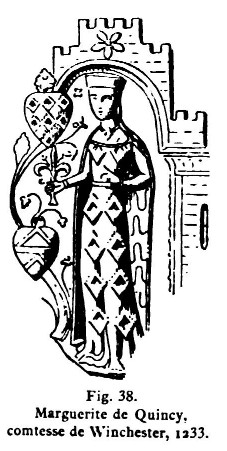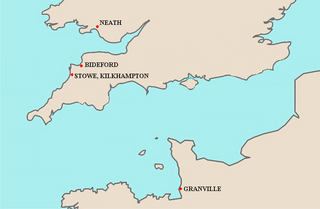
Robert FitzRoy, 1st Earl of Gloucester was an illegitimate son of King Henry I of England. He was the half-brother of the Empress Matilda, and her chief military supporter during the civil war known as the Anarchy, in which she vied with Stephen of Blois for the throne of England.

Robert Fitzhamon, or Robert FitzHamon, Seigneur de Creully in the Calvados region and Torigny in the Manche region of Normandy, was the first Norman feudal baron of Gloucester and the Norman conqueror of Glamorgan, southern Wales. He became Lord of Glamorgan in 1075.

Gilbert de Clare, 4th Earl of Hertford, 5th Earl of Gloucester, 1st Lord of Glamorgan, 7th Lord of Clare was the son of Richard de Clare, 3rd Earl of Hertford (c. 1153–1217), from whom he inherited the Clare estates. He also inherited from his mother, Amice Fitz William, the estates of Gloucester and the honour of St. Hilary, and from Rohese, an ancestor, the moiety of the Giffard estates. In June 1202, he was entrusted with the lands of Harfleur and Montivilliers in Normandy.
Geoffrey Fitz Peter, Earl of Essex was a prominent member of the government of England during the reigns of Richard I and John. The patronymic is sometimes rendered Fitz Piers, for he was the son of Piers de Lutegareshale, a forester of Ludgershall and Maud de Manderville.
The title of Earl of Gloucester was created several times in the Peerage of England. A fictional earl is also a character in William Shakespeare's play King Lear.

Hugh of Cyfeiliog, 5th Earl of Chester, also written Hugh de Kevilioc, was an Anglo-Norman magnate who was active in England, Wales, Ireland and France during the reign of King Henry II of England.
Richard de Clare, 3rd Earl of Hertford, feudal baron of Clare in Suffolk, and lord of Tonbridge in Kent and of Cardigan in Wales, was a powerful Anglo-Norman nobleman with vast landholdings in England and Wales.
Ifor Bach also known as Ifor ap Meurig and in anglicised form Ivor Bach, Lord of Senghenydd, was a twelfth-century resident in and a leader of the Welsh in south Wales.
Baldwin de Redvers, 1st Earl of Devon, feudal baron of Plympton in Devon, was the son of Richard de Redvers and his wife Adeline Peverel.

The House of Clare was a prominent Anglo-Norman noble house that ruled the Earldoms of Pembroke, Hertford and Gloucester in England and Wales throughout its history, playing a prominent role in the Norman invasion of Ireland.
Isabella, Countess of Gloucester, was an Anglo-Norman noblewoman who was the first wife of King John of England.

The Lordship of Glamorgan was one of the most powerful and wealthy of the Welsh Marcher Lordships. The seat was Cardiff Castle. It was established by the conquest of Glamorgan from its native Welsh ruler, by the Anglo-Norman nobleman Robert FitzHamon, feudal baron of Gloucester, and his legendary followers the Twelve Knights of Glamorgan. The Anglo-Norman Lord of Glamorgan, like all Marcher lords, ruled his lands directly by his own law: thus he could, amongst other things, declare war, raise taxes, establish courts and markets and build castles as he wished, without reference to the Crown. These privileges were only lost under the Laws in Wales Acts 1535–1542. Though possessing many castles, the main seat of the Lordship was Cardiff Castle.
Maud de Lacy was an English noblewoman, being the eldest child of John de Lacy, 2nd Earl of Lincoln, and the wife of Richard de Clare, 5th Earl of Hertford, 6th Earl of Gloucester.
Maud of Gloucester, Countess of Chester, also known as Matilda, was an Anglo-Norman noblewoman and the daughter of Robert, 1st Earl of Gloucester, an illegitimate son of King Henry I of England, and Mabel, daughter and heiress of Robert Fitzhamon. Her husband was Ranulf de Gernon, 4th Earl of Chester.
Mabel FitzRobert, Countess of Gloucester was an Anglo-Norman noblewoman, and a wealthy heiress who brought the lordship of Gloucester, among other prestigious honours to her husband, Robert, 1st Earl of Gloucester upon their marriage. He was the illegitimate son of King Henry I of England.

Margaret de Quincy, suo jure 2nd Countess of Lincoln was a wealthy English noblewoman and heiress having inherited in her own right the Earldom of Lincoln and honours of Bolingbroke from her mother Hawise of Chester, received a dower from the estates of her first husband, and acquired a dower third from the extensive earldom of Pembroke following the death of her second husband, Walter Marshal, 5th Earl of Pembroke. Her first husband was John de Lacy, 2nd Earl of Lincoln, by whom she had two children. He was created 2nd Earl of Lincoln by right of his marriage to Margaret. Margaret has been described as "one of the two towering female figures of the mid-13th century".
Milo de Cogan was an Anglo-Norman knight from Glamorgan who played a significant role in the Norman conquest of Ireland under Richard de Clare, 2nd Earl of Pembroke; a man better known to Irish history as Strongbow.
The feudal barony of Gloucester or Honour of Gloucester was one of the largest of the mediaeval English feudal baronies in 1166, comprising 279 knight's fees, or manors. The constituent landholdings were spread over many counties. The location of the caput at Gloucester is not certain as Gloucester Castle appears to have been a royal castle, but it is known that the baronial court was held at Bristol in Gloucestershire.

Sir Richard de Grenville was one of the Twelve Knights of Glamorgan who served under Robert FitzHamon, in the conquest of Glamorgan in Wales. He obtained from FitzHamon the lordship of Neath in which he built Neath Castle and in 1129 founded Neath Abbey. He is by tradition the founder and ancestor of the prominent Westcountry Grenville family of Stowe in the parish of Kilkhampton in Cornwall and of Bideford in Devon, the later head of which family was John Granville, 1st Earl of Bath (1628–1701). The surname of his supposed descendants the Westcountry Grenville family was spelled by tradition "Grenville" until 1661 when it was altered to "Granville".
Amaury III was the Count of Évreux in Normandy from 1181 until his death. He belonged to the elder line of the Montfort family, and is sometimes known as Amaury V de Montfort.










